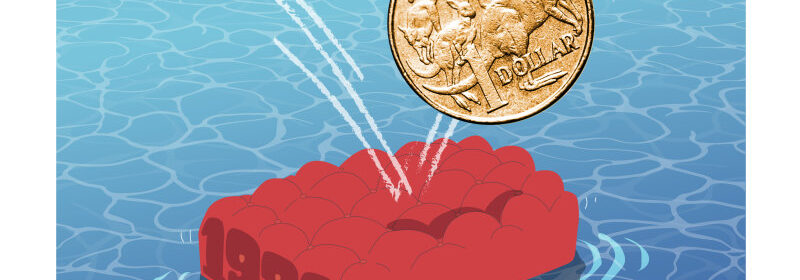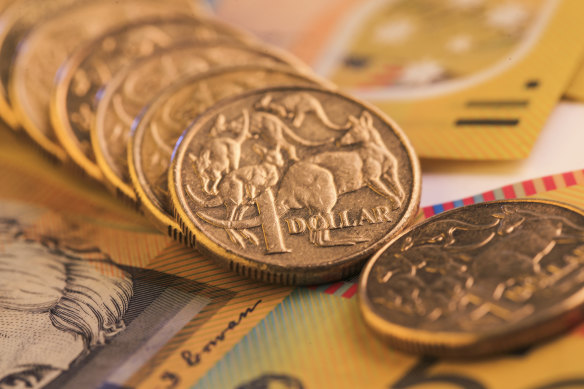The 40-year-old change that has made the Reserve Bank’s job easier

Save articles for later
Add articles to your saved list and come back to them any time.
While we’ve been laser focused on the battle to curb inflation, a middle-aged shock-absorber has made the Reserve Bank’s job a little easier.
Shortly after landing in the top seat of Australian politics in 1983, Bob Hawke floated the Australian dollar. Now, he’s not the protagonist of this story, but the decision he made to unshackle the local currency from its peers has shaped the Australian economy for the past few decades.
This month marks the 40th birthday of the floating Aussie dollar, which has helped us steer through some huge crises. But what is it? And how does it help?
Bob Hawke’s move to float the dollar 40 years ago has shaped Australia’s monetary policy ever since.Credit: Wayne Taylor
You may have heard phrases such as “the Australian dollar has gone up”, or that it’s “weaker”, but it’s always – if sometimes tacitly – compared with something else.
There are two main ways to measure the value of our dosh against other currencies. Bilateral exchange rates are the most quoted and what you probably care about when you travel, order goods from another country, or purchase overseas inputs for your business. It’s where we weigh up the value of a currency against that of another country, often the US dollar.
A rising AUD/USD exchange rate means each Australian dollar buys more US dollars than before.
Since moving to a floating exchange rate in 1983, the Reserve Bank has been mostly relieved of its duty to manipulate the value of the Aussie dollar.
The trade-weighted index (TWI) is a broader gauge. It measures whether a country’s currency is rising or falling in value, on average, relative to its trading partners. The currencies of bigger trading partners are more heavily weighted when calculating the TWI. For Australia, China’s renminbi and Japan’s yen account for roughly 31 per cent and 13 per cent respectively of Australia’s TWI because they’re our biggest trading partners.
The exchange rate you see quoted is determined by the system a country chooses.
When a currency is “floating”, its value (or price in terms of other currencies) is determined, like most other things, by demand and supply. That may seem like a no-brainer, but Australia has dipped its toes in nearly every other exchange rate system in existence.
We’ve “pegged”, or fixed, the Australian dollar to move in line with the US dollar and commodities such as gold. We’ve also tried a hybrid system: the “moving peg” where the exchange rate is allowed to fluctuate within a range.
For these pegged systems to work, a monetary authority – such as the Reserve Bank – has to buy or sell currency in the foreign exchange market, tipping the scale of demand and supply that influences the value of currency.
But it also leaves them with a dilemma. That’s because economies are incredibly complicated and dynamic. What seems like a good level to fix an exchange rate one year may not be forever. And the policy the Reserve Bank uses will not just affect the dollar. It will affect jobs, inflation, and businesses.
We’ve seen higher interest rates used by the Reserve Bank to slow demand in our economy and beat down inflation. But interest rates can also make a country’s currency more or less attractive to investors.
If a central bank is forced to keep a currency in line, or “pegged” to something else, it limits how it can use tools like the interest rate – which also affect the currency – to stabilise the economy.
When interest rates in Australia increase, relative to those overseas, it makes some Australian assets such as government bonds more attractive to foreign and domestic investors. The more Aussie assets they purchase, the more money flows into Australia – and the more demand it generates for Australian dollars. Investors are also less likely to purchase overseas assets, meaning they won’t be looking to trade in their Australian dollars, limiting supply of the currency. These two levers drive up the exchange rate, and move in the opposite direction when Aussie interest rates fall relative to that of other countries.
Bob Hawke won a landslide for Labor in March 1983.Credit: David James Bartho/Fairfax Media
Since moving to a floating exchange rate in 1983, the Reserve Bank has been mostly relieved of its duty to manipulate the value of the Aussie dollar. Instead of worrying about how it might affect the Aussie dollar, it’s been able to focus on keeping inflation and jobs stable.
Australia emerged relatively unscathed from the global financial crisis, largely because of factors including strong demand for our commodities from China. But the Reserve Bank was also able to lower the cash rate, helping to stimulate demand and get businesses back on their feet.
The floating of the Australian dollar has also helped the economy to manage external shocks without the big inflationary or deflationary pressures which plagued the past. During the mining boom, we kept a lid on inflation despite increased demand for Australian resources by allowing the Australian dollar to do its thing.
When demand – or prices – of Australian exports increases relative to imports, it leads to a higher Australian dollar because overseas buyers need more Aussie dollars to buy our goods and services. Towards the end of the mining boom in 2011, the Australian dollar reached a record high of $1.10 against the US dollar, lowering the cost of imported goods and helping to dampen the inflation that we might otherwise have seen.
In the near-term, speculation and risk sentiment can also influence the exchange rate. When Australia’s economic outlook improves, investors are generally more open to taking on risk, and drive demand for Aussie dollars, leading to – you got it – an increase in the value of the Australian dollar.
Just this week, the Aussie dollar reached an almost four-month high of US66.5 cents, mostly driven by expectations that the US equivalent of the Reserve Bank – the Federal Reserve – might start cutting interest rates earlier than expected. With the RBA still mulling another rate rise, expectation that US interest rates might fall relative to Australian interest rates drove a swing against the US dollar, towards other currencies such as the Australian dollar.
We might hate the floating exchange rate when hard-earned Aussie dollars buy us less overseas, but if we had a dollar for every shock it absorbed, we mightn’t mind.
Ross Gittins is on leave.
The Business Briefing newsletter delivers major stories, exclusive coverage and expert opinion. Sign up to get it every weekday morning.
Most Viewed in Business
From our partners
Source: Read Full Article


